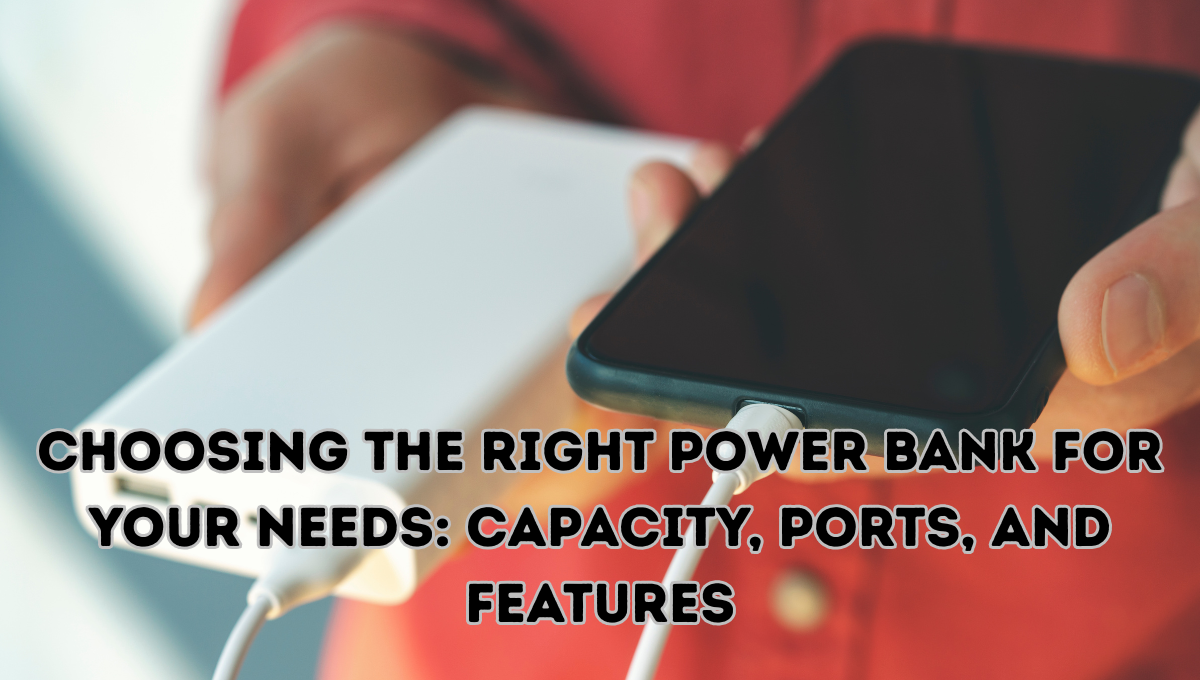
Blogs
Choosing the Right Power Bank for Your Needs: Capacity, Ports, and Features

Our current way of life depends on mobile devices. Thus, a basic need is having enough power all day. Regular travelers, business people, and anybody requiring power away from home should buy a top-quality power bank.
Although numerous portable chargers are on the market, picking the perfect one can be challenging. This blog outlines what you need to know about choosing a power bank so you may select the right one for your purpose.
Understanding the Factors That Determine Your Best Power Bank Selection
Choosing a power bank requires more than picking any random model available. Deciding which power bank to buy depends on matching your power requirements with the device specifications. This section explains all the essential points you need to evaluate before buying.
1. Wired vs. Wireless Charging: Which Is Superior?
There are two primary varieties of power banks: wireless and wired. The best power bank choice depends on your device charging habits and preference for fast charging methods.
Wired Power Banks
A wired power bank lets you charge your device by plugging it into the power bank. Because they have more than one USB charging port, these power banks can be used with various electronics. They work well for users who need an easy solution to charge several devices through a single device.
Wireless Power Banks (Magnetic Chargers)
Wireless power banks function as magnetic chargers to deliver cordless device charging. The Qi technology enables wireless power banks to charge any placed device by simply resting it on their charging pads. Modern power banks with built-in magnets work perfectly for MagSafe devices, including iPhone models. Both easy usage and portability exist for these chargers, but they deliver slower charging speeds than traditional wired chargers.
A magnetic wireless power bank would suit your needs best since it offers convenience and portability when charging MagSafe devices.
2. Power Bank Capacity: What does mAh mean, and why does it matter
The mAh rating tells you how much energy storage the power bank includes and what its charging cycles are for devices. The digital display means a device can save more energy and provide more battery life for charging.
How to Determine the Right mAh
For smartphones: Most smartphones will receive one to two full charges using a power bank whose capacity measures between 10,000 and 20,000 mAh. With this feature, you can charge your phone one or twice without recharging the power bank.
For tablets and laptops: Power banks that charge tablets and laptops need more capacity to provide sufficient energy storage. A power bank with 20,000 or greater mAh value delivers adequate power for these devices.
For ultra-portable power banks: Choose a small power bank sized for emergencies with 5 to 8 thousand mAh for quick mobile phone charge boosts during the day.
3. Speed at Which a Power Bank Charges Device Batteries
Those who need to power up their devices fast require charging solutions with good speed performance. Fast-charging devices enable you to recharge your electronic batteries much faster for instant use in urgent situations.
Finding Power Banks for Fast Charging
Power Delivery (PD): This technology allows devices to power up through USB-C links at three times the regular speed of familiar chargers. Modern smartphones like the iPhone and Samsung Galaxy models rely on fast charging. Hence, those who require rapid power-ups must pay great attention to it.
Qualcomm Quick Charge (QC): Designed for smartphones with Snapdragon CPUs, Qualcomm Quick Charge (QC) is a fast-charging technology. Seek power banks with Quick Charge technology through levels 3.0 and 4.0 to get fast-charging outcomes.
The right fast-charging power bank lets you recharge your smartphone to 50% in 30 minutes.
4. Can a power bank charge many devices?
Charge multiple devices with a power bank with USB ports and wireless charging. This allows simultaneous charging of tablets, different models of smartwatches, phones, and earbuds, making it quicker for users.
Key Considerations for Multi-Device Charging
Port types: Choose power banks to charge different devices depending on USB-A, USB-C, and Lightning connectors.
Charging capacity: To charge multiple devices quickly, the charged power amount (mAh) must be higher than the total number of ports.
Wireless charging support: These power banks allow users to charge two devices wirelessly simultaneously quickly, thanks to their wireless charging feature, which benefits consumers of Apple products.
5. Evaluate how easily you can transport your power bank due to its design and size.
Consider your travel needs before picking a power bank, affecting how you carry and store it.
Compact models: People do their travel commute efficiently, while small-sized power banks let you charge on the move quickly. Smaller power banks provide smaller charging power and fewer connection points as standard.
Larger models: These units' large size offers increased power capacity, speedier charging times, and additional ports to manage multiple devices simultaneously. Powering multiple devices for extended travel requires a larger model, which suits users requiring mobile laptop charges.
6. Additional Features Provide Value Through Their Extra Capabilities
Power banks with additional features provide users with better convenience and improved functionality. When deciding on a power bank, these features should be evaluated:
Safety Features: Safety Features in power banks protect both devices and the power bank through overcharge protection, overheat protection, and short-circuit protection.
Design and Build Quality: Functional design quality cannot be overlooked when selecting your power bank. Power banks made from specific materials demonstrate both durability and visual attractiveness. If you intend to use them in harsh outdoor or demanding situations, choose a power bank made for rugged use.
Brand Reputation: Some power banks are of superior quality. Choose power bank suppliers who offer proven reliability and quality guarantees. Reading reviews and checking ratings can help you better understand product performance and durability.
LED Indicators: Power banks' LED indicators show battery status, enabling customers to recharge promptly.
Solar Charging: An outdoor-friendly solar-powered power bank charges electronics using sustainable solar power.
Built-in cable: The power bank's integrated wires remove the need for separate charging cords.
Use Case Scenarios
Various lifestyle requirements demand power banks specific to individual needs. Several daily scenarios exist to help determine your best power bank fit.
The Frequent Traveler
Your global exploration depends on multiple electronic gadgets, including a smartphone, a tablet, a camera, and possibly a laptop. The requirements for this scenario call for a large power bank reaching 20,000mAh or more functionality with multiple power output points for charging multiple devices at once. Choosing power banks that feature Quick Charge or Power Delivery features would be beneficial.
The Daily Commuter
You spend your days commuting to various locations without electrical outlets. A power bank with a 10,000mAh capacity will provide enough charging power for your smartphone and possibly a tablet throughout your daily use.
The Outdoor Enthusiast
A power bank designed for camping and outdoor adventures must be highly durable. Your priority should be rugged power banks built to withstand weather and have higher capacity. The devices incorporate integrated flashlights and solar recharging capabilities.
Practical Tips and Final Thoughts
You now have enough knowledge to choose the perfect power bank, but these practical guidelines will help you maximize its performance:
Review your portable charging requirements to determine power usage while estimating suitable mAh capacity levels.
Confirm that your power bank works with your devices by checking the charging methods and the ports used for connection.
Customer evaluations in reviews deliver accurate information about the realistic performance and operational durability of products.
A premium power bank, which costs slightly more and has better features, will be financially advantageous over an extended period.
Final Words:
When choosing portable chargers, it is important to consider all the factors mentioned above. This blog will help buyers choose the correct charger for their specific requirements.
